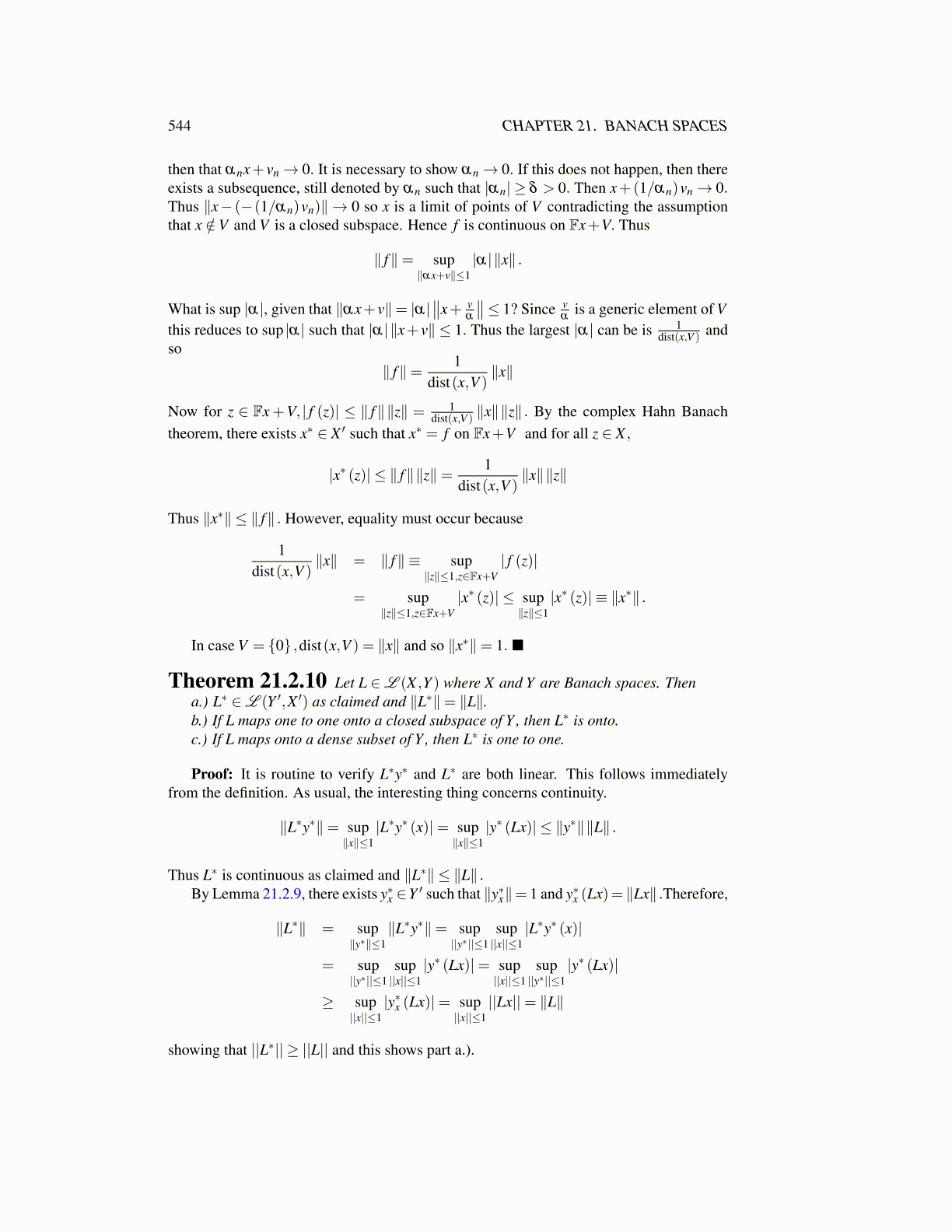
544 CHAPTER 21. BANACH SPACES
then that αnx+ vn→ 0. It is necessary to show αn→ 0. If this does not happen, then thereexists a subsequence, still denoted by αn such that |αn| ≥ δ > 0. Then x+(1/αn)vn→ 0.Thus ∥x− (−(1/αn)vn)∥ → 0 so x is a limit of points of V contradicting the assumptionthat x /∈V and V is a closed subspace. Hence f is continuous on Fx+V. Thus
∥ f∥= sup∥αx+v∥≤1
|α|∥x∥ .
What is sup |α|, given that ∥αx+ v∥= |α|∥∥x+ v
α
∥∥≤ 1? Since vα
is a generic element of Vthis reduces to sup |α| such that |α|∥x+ v∥ ≤ 1. Thus the largest |α| can be is 1
dist(x,V ) andso
∥ f∥= 1dist(x,V )
∥x∥
Now for z ∈ Fx +V, | f (z)| ≤ ∥ f∥∥z∥ = 1dist(x,V ) ∥x∥∥z∥ . By the complex Hahn Banach
theorem, there exists x∗ ∈ X ′ such that x∗ = f on Fx+V and for all z ∈ X ,
|x∗ (z)| ≤ ∥ f∥∥z∥= 1dist(x,V )
∥x∥∥z∥
Thus ∥x∗∥ ≤ ∥ f∥ . However, equality must occur because
1dist(x,V )
∥x∥ = ∥ f∥ ≡ sup∥z∥≤1,z∈Fx+V
| f (z)|
= sup∥z∥≤1,z∈Fx+V
|x∗ (z)| ≤ sup∥z∥≤1
|x∗ (z)| ≡ ∥x∗∥ .
In case V = {0} ,dist(x,V ) = ∥x∥ and so ∥x∗∥= 1. ■
Theorem 21.2.10 Let L ∈L (X ,Y ) where X and Y are Banach spaces. Thena.) L∗ ∈L (Y ′,X ′) as claimed and ∥L∗∥= ∥L∥.b.) If L maps one to one onto a closed subspace of Y , then L∗ is onto.c.) If L maps onto a dense subset of Y , then L∗ is one to one.
Proof: It is routine to verify L∗y∗ and L∗ are both linear. This follows immediatelyfrom the definition. As usual, the interesting thing concerns continuity.
∥L∗y∗∥= sup∥x∥≤1
|L∗y∗ (x)|= sup∥x∥≤1
|y∗ (Lx)| ≤ ∥y∗∥∥L∥ .
Thus L∗ is continuous as claimed and ∥L∗∥ ≤ ∥L∥ .By Lemma 21.2.9, there exists y∗x ∈Y ′ such that ∥y∗x∥= 1 and y∗x (Lx)= ∥Lx∥ .Therefore,
∥L∗∥ = sup∥y∗∥≤1
∥L∗y∗∥= sup||y∗||≤1
sup||x||≤1
|L∗y∗ (x)|
= sup||y∗||≤1
sup||x||≤1
|y∗ (Lx)|= sup||x||≤1
sup||y∗||≤1
|y∗ (Lx)|
≥ sup||x||≤1
|y∗x (Lx)|= sup||x||≤1
||Lx||= ∥L∥
showing that ||L∗|| ≥ ||L|| and this shows part a.).